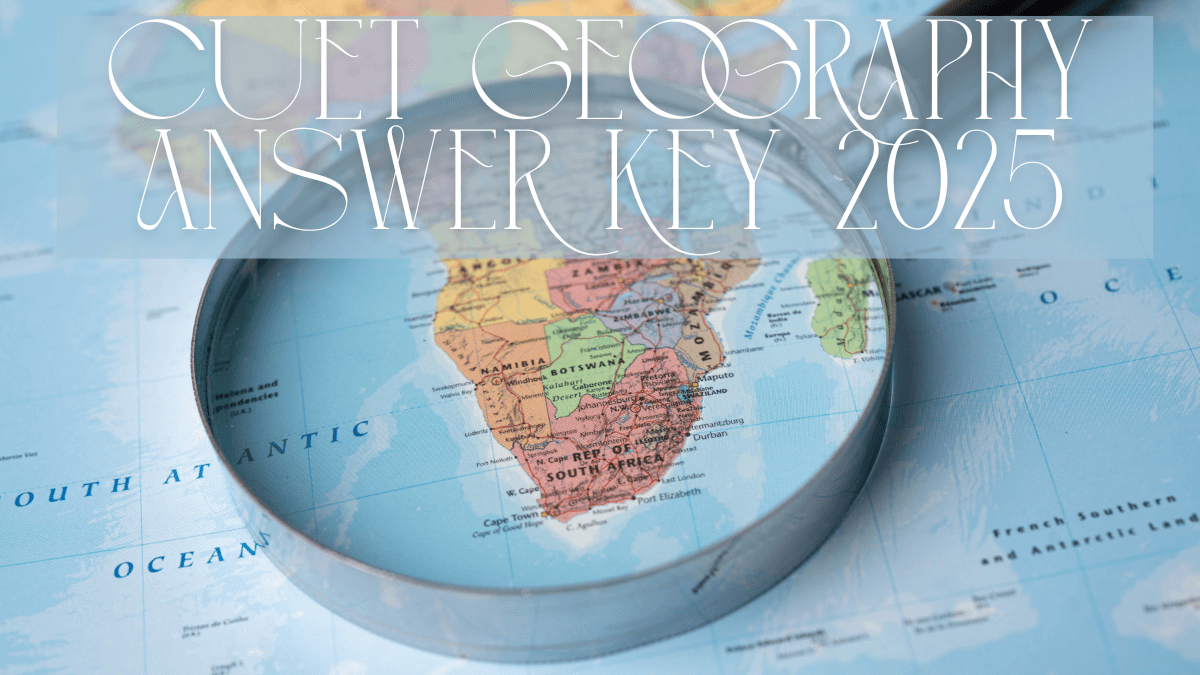The National Testing Agency (NTA) will release the CUET Geography Answer Key 2025 PDF very soon before the announcement of CUET results. According to student and teacher reviews, the CUET Geography Question Paper 2025 was moderate to difficult level. The Geography exam of CUET UG 2025 is held from May 13 to June 3, 2025. The Geography paper is part of Section II in the curriculum. Geomorphology, Climatology, Oceanography, Population Geography, GIS & Remote Sensing are some important topics covered in the question paper. Read the complete article to know the Geography paper level, exam analysis, Questions with solutions and more.
CUET Geography Answer Key 2025
CUET Geography Answer Key 2025 includes the questions with the answers that are asked in the different shifts of the Geography exam. The Geography Question paper includes questions from topics like Transport, Human Geography, Communication and Trade, Human Settlements, and so on. Candidates planning to get admission through CUET in the upcoming year in a course that requires Geography must review all the questions here to know everything about the exam.
CUET Geography Paper 2025 Analysis
The CUET Geography Paper 2025 includes 50 questions, each carrying 5 marks. The complete paper of 250 marks. The Geography exam 2025 is to be attempted within 60 minutes. Each correct answer in the answer sheet will be awarded 5 marks, while 1 mark will be deducted for each incorrect answer from the total obtained marks. Earlier, the CUET Geography exam had 50 questions, where students had to answer only 40 questions as compulsory. But in 2025, students will have to answer all 50 questions within the 1-hour duration as the exam pattern is revised test.
CUET UG 2025 Question Paper Level
The CUET UG 2025 question paper was of a moderate level, We will update more critical analysis after June 3rd. Check the year-wise paper level over the years.
| CUET Geography Question Paper Difficulty Level | |
| Year | Difficulty Level |
| CUET Geography Question Paper 2025 (Expected) | Moderate to Difficult |
| CUET Geography Question Paper 2024 | Moderate |
| CUET Geography Question Paper 2023 | Moderate |
| CUET Geography Question Paper 2022 | Easy to Moderate |
CUET 2025 Geography Question Paper with Answer PDF
The CUET Geography exam 2025 has started on 13th May. The CUET Geography Answer key 2025 along with the question paper PDF, will be shared soon on this page. Here are some moderate to difficult level geography question with answers below –
Questions with Answers
Question 1: Arrange the following states in descending order according to their total population in 2011.
(A) Maharashtra
(B) Bihar
(C) Uttar Pradesh
(D) West Bengal
Choose the correct answer from the options given below:
Answer – Option is C
Solution – 1
To determine the order of states by total population in 2011, we need to rely on census data from that year. Here is the correct descending order based on their populations:
Uttar Pradesh (C): The most populous state in India.
Maharashtra (A): The second most populous state.
Bihar (B): The third most populous state.
West Bengal (D): The fourth most populous among the given states.
From this analysis, the order from highest to lowest population is: (C), (A), (B), (D), which matches the given correct answer.
Solution -2
According to the 2011 Census of India, the population distribution across states was as follows:
Uttar Pradesh: With a population of over 200 million, Uttar Pradesh was the most populous state in India in 2011. It is located in the northern part of the country and plays a significant role in India’s political, economic, and cultural landscape.
Maharashtra: Maharashtra ranked second in population, with a population of around 112 million. This state is known for its economic strength, with Mumbai being the financial capital of India.
Bihar: Bihar, with a population of around 104 million, ranked third in terms of population size. It is located in eastern India and has a rich historical and cultural heritage.
West Bengal: West Bengal, with a population of over 91 million, ranked fourth. Situated in the eastern region, it is known for its vibrant culture, heritage, and political significance.
Question 2: Match List-I with List-II:
List-I (Stage of Demographic Transition) List-II (Country/Tribe)
(A) High Fluctuating Stage (I) Rainforest tribes
(B) Early Expanding Stage (II) Angola
(C) Low Fluctuating Stage (III) India
(D) Late Expanding Stage (IV) Japan
Choose the correct answer from the options given below:
A. (A)-(I), (B) – (II), (C) – (III), (D) – (IV)
B. (A)-(I), (B) – (II), (C) – (IV), (D) – (III)
C. (A)-(I), (B) – (III), (C) – (II), (D) – (IV)
D. (A)- (III), (B) – (IV), (C) – (I), (D) – (II)
Answer – The Correct Option is B
Solution – 1
The question requires matching stages of demographic transition with corresponding countries or tribes. Let’s examine these stages and the respective matches:
Stages of Demographic Transition
(A) High Fluctuating Stage
This stage is characterized by high birth and death rates, leading to a stable and low population growth. This is typical of pre-industrial societies, often seen in indigenous and remote rainforest tribes. Thus, the match is (A)-(I) Rainforest tribes.
(B) Early Expanding Stage
This stage experiences high birth rates and declining death rates, resulting in rapid population growth. Many developing countries, such as Angola, are in this stage. Hence, (B)-(II) Angola is correct.
(C) Low Fluctuating Stage
This involves low birth and death rates with slow population growth. It’s typical of economically developed countries like Japan, indicating stable and low population growth. Therefore, the correct match is (C)-(IV) Japan.
(D) Late Expanding Stage
This stage represents decreasing birth and death rates with moderate growth. Countries like India, which are advancing economically and industrially, fit this. Thus, the appropriate match is (D)-(III) India.
By analyzing these stages, we confirm the correct answer: (A)-(I), (B)-(II), (C)-(IV), (D)-(III).
Solution -2
The demographic transition model explains the changes in population growth patterns over time, based on shifts in birth and death rates. The stages of demographic transition are linked to different countries or tribes, reflecting their stages of development and population dynamics. Below are the stages and their corresponding examples:
High Fluctuating Stage: This stage is characterized by high birth and death rates, leading to minimal population growth. Rainforest tribes are an example, as their populations are influenced by factors such as disease, limited healthcare, and subsistence agriculture, which result in fluctuating population sizes.
Early Expanding Stage: In this stage, death rates begin to fall due to improvements in healthcare and sanitation, while birth rates remain high, leading to rapid population growth. Angola is an example of a country in this stage, where significant improvements in healthcare have reduced mortality rates, but high fertility rates still contribute to fast population growth.
Low Fluctuating Stage: Birth rates and death rates are both low, resulting in a stable or slowly growing population. Japan is an example of a country in this stage, with a highly developed economy, advanced healthcare system, and low fertility rates, leading to a stable or even declining population.
Late Expanding Stage: Birth rates start to decline, following the drop in death rates, leading to slower population growth. India represents this stage, as it is experiencing a decline in fertility rates due to urbanization, improved access to healthcare, and family planning, although the population is still growing at a moderate pace.
The stages of demographic transition are not uniform across all countries, as they are influenced by various social, economic, and cultural factors. Understanding these stages helps to analyze and predict population trends, which are crucial for formulating policies related to healthcare, education, and economic development.









 CLAT Exam Analysis 2026 OUT, Know Sectio...
CLAT Exam Analysis 2026 OUT, Know Sectio...
 CLAT Colleges 2026 List: Check Top Unive...
CLAT Colleges 2026 List: Check Top Unive...
 CLAT Provisional Answer Key 2026 Release...
CLAT Provisional Answer Key 2026 Release...








